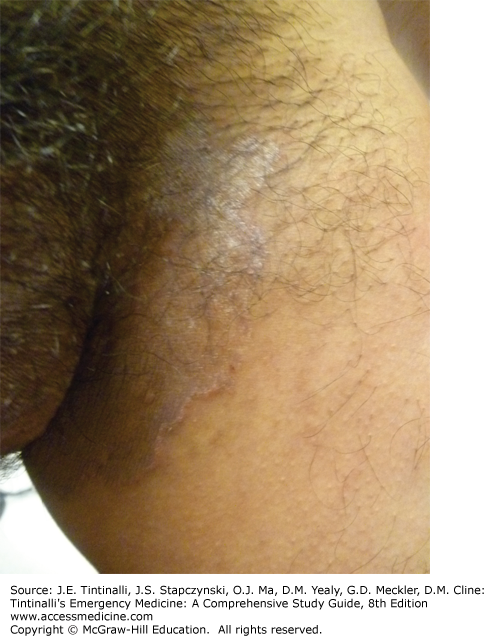INTRODUCTION
The skinfolds of the body include the groin, intergluteal cleft, axilla, inframammary, and pannus regions. The skinfolds have unique characteristics that set them apart from other regions of the body. For one, these areas are almost continuously occluded. As a result, scale does not develop; maceration and fissuring develop instead. This situation alters the appearance of papulosquamous diseases and inflammatory processes. The occlusion also allows for the development of a warm, moist environment favorable to the growth of fungi, yeast, and bacteria. Although many skin diseases can affect the skinfolds to some degree, this chapter focuses on common disorders where skinfold eruptions are the main finding. This chapter discusses common infections, infestations, and inflammatory and reactive conditions that involve the groin and skinfolds. Sexually transmitted infections are discussed in chapter 149. Molluscum contagiosum is discussed in chapter 251.
An important point for treatment of intertriginous diseases is avoiding combination corticosteroid/antifungal products. Although processes in the groin folds can be confusing and complicated by secondary change, using combination products may further cloud the clinical picture. If improvement is seen, it is difficult to ascertain which medication prompted the change. And, finally, the corticosteroid component of these medications is too strong to be used in the occluded intertriginous skin and may produce irreversible striae with long-term use.1
INFECTIONS
Tinea cruris is a fungal infection of the groin commonly called jock itch. It is very common in males, uncommon in females, and exceedingly rare in children. Tinea cruris results from invasion of the stratum corneum by the dermatophyte types of fungi (see Table 253-4). It is transmitted via direct contact (person to person, or animal [usually kittens or puppies] to person) or fomites.
Examination is significant for symmetric erythema with a peripheral annular slightly scaly edge (Figure 252-1). The groin is typically involved, and the process may extend onto the inner thighs and even the buttocks. The penis and scrotum are typically spared, a distinguishing feature of tinea cruris because most other eruptions will affect the scrotum. Frequently, tinea pedis is also found and the dermatophyte infection may be spread from the feet to the groin through putting on clothes.
Scraping the leading edge and performing a potassium hydroxide examination (see Table 252-6) will demonstrate branching hyphae (see Figure 252-1), unless the patient has recently applied topical antifungal preparations. If a potassium hydroxide examination is negative, consider one of the other disorders discussed in this chapter (Table 252-1).
Infection
Infestation
Dermatitis
Neoplasia
Miscellaneous disorders
|
Treatment is with antifungal creams, such as clotrimazole, ketoconazole, or econazole, twice a day (Table 252-2). Clotrimazole is often suggested initially because it is a low-cost treatment and is available without a prescription. Econazole also has antibacterial properties and is preferred if maceration is present. Treatment also includes keeping the affected area as cool and dry as possible, which is facilitated by wearing loose-fitting clothing. Use an antifungal powder daily to prevent recurrences. Recommend follow-up with a primary care provider or dermatologist if the eruption has not resolved in 4 to 6 weeks.
| Generic | Trade | Formulations | Pregnancy Category | Sizes (grams) | Cost (U.S. $) | Status |
|---|---|---|---|---|---|---|
| Clotrimazole | Lotrimin | 1% cream or solution | B | Cream (15, 30) | Cream (8–16) | OTC |
| Mycelex | Solution (10, 30) | Solution (12–22) | ||||
| Ketoconazole | Nizoral | 2% | C | Cream (15, 30, 60) | Cream (15–36) | Prescription |
| Kuric gel | Gel (15) | |||||
| Xolegel | ||||||
| Econazole | Spectazole | 1% | C | Cream (15, 30, 85) | Cream (15–50) | Prescription |
| Miconazole | Zeasorb AF | 2% | C | Powder (56) | Powder (9) | OTC |
Candidal infections of the skin favor moist, occluded areas of the body. Although any skinfold may be involved, superficial Candida infections are commonly seen in the diaper area of infants, vulva and groin of women, glans penis (balanitis) of uncircumcised males, and inframammary and pannus folds of obese patients. Antibiotic therapy, systemic corticosteroid therapy, urinary or fecal incontinence, immunocompromised states, poorly controlled diabetes mellitus, and obesity are predisposing factors. Women with vulvar or inner thigh involvement will often have vaginal candidiasis as well. Frequently, Candida infection may complicate other inflammatory intertriginous disorders.
Stay updated, free articles. Join our Telegram channel

Full access? Get Clinical Tree








